-
info@aaanimalcontrol.com
Call us for help in your town
Humane Wildlife Education
Squirrels in the Attic - How to Get Squirrels Out of an Attic
Read the below tutorial for information about the Eastern Gray Squirrel and how to get it out of an attic. It's not always a simple task - getting squirrels out of the attic usually requires these four steps:
- 1) Physical removal of baby squirrels, or waiting 4-6 weeks for them to grow to adult size
- 2) Humane trapping or exclusion of all adult squirrels
- 3) Repairs to the entry points and exclusion work
- 4) Cleanup of waste such as squirrel feces and nesting material.
The following instructions, tips, and info should help in do squirrel removal process yourself. But if you need professional help solving the squirrel in attic problem in your hometown, we service over
500 USA locations! Click here to hire us in your town and check prices - updated for year 2020.
After you read the below information, you may want to click on one of these guides that I wrote:
How much does squirrel removal cost? - get info on prices.
How to get rid of squirrels - my main squirrel info guide.
Example squirrel trapping photographs - get do-it-yourself ideas.
Squirrel job blog - learn from squirrel jobs I've done.
 Squirrels love to live in attics!
This is one of the most common
human-wildlife conflicts. Squirrels are
usually arboreal, meaning that they prefer
to live in trees. In the wild, squirrels
will build a nest made of leaves and twigs
high up in a tree. However, squirrels are
very adaptable animals, and thrive in
suburban and urban environments. They are
opportunistic, and many have found that
the attics of homes make a great place to
live. An attic is like a big old hollow
tree to a squirrel, and it has a lot of
advantages - it's dry, warm, and safe from
predators. Squirrels can climb almost
anything, and they are spectacular
chewers, so they have no problem climbing
to a vulnerable area of your roof, and
chewing their way in.
Squirrels love to live in attics!
This is one of the most common
human-wildlife conflicts. Squirrels are
usually arboreal, meaning that they prefer
to live in trees. In the wild, squirrels
will build a nest made of leaves and twigs
high up in a tree. However, squirrels are
very adaptable animals, and thrive in
suburban and urban environments. They are
opportunistic, and many have found that
the attics of homes make a great place to
live. An attic is like a big old hollow
tree to a squirrel, and it has a lot of
advantages - it's dry, warm, and safe from
predators. Squirrels can climb almost
anything, and they are spectacular
chewers, so they have no problem climbing
to a vulnerable area of your roof, and
chewing their way in.
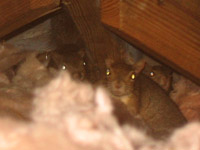 Although several species of squirrel can
live in attics, including flying
squirrels, red squirrels, and more, this
article deals with the most common, the
Eastern Gray Squirrel. Most commonly, the
squirrel living in your attic is a female
with a litter of baby squirrels. If you
have several squirrels in your attic,
there's a good chance that it's the mother
and her young. The young grow very
quickly, and reach adult size in only
about six weeks, at which point they start
running around the place like crazy,
scratching, chewing, and doing the things
that squirrels do. In this photo, I've
discovered four squirrels living in an
attic - a mother and her three juveniles.
Although several species of squirrel can
live in attics, including flying
squirrels, red squirrels, and more, this
article deals with the most common, the
Eastern Gray Squirrel. Most commonly, the
squirrel living in your attic is a female
with a litter of baby squirrels. If you
have several squirrels in your attic,
there's a good chance that it's the mother
and her young. The young grow very
quickly, and reach adult size in only
about six weeks, at which point they start
running around the place like crazy,
scratching, chewing, and doing the things
that squirrels do. In this photo, I've
discovered four squirrels living in an
attic - a mother and her three juveniles.
 Eastern Gray Squirrels have two
litters of young per year. The timing can
vary depending on the part of the country,
but there's usually a litter born in
winter, and another born in late summer.
After a pregnancy of about 44 days, the
mother gives birth to usually around 3-4
small, naked, babies, with eyes sealed
shut. They are only about one inch long
and one ounce heavy at birth, but they
grow quickly. By about four weeks they're
up and about, and by six weeks, they're at
close to adult size, and by three months
or so, they're pretty much adults. They
will usually stay in the attic up until
the time the mother is ready to bear her
next litter of young. In the meantime,
they'll chew, urinate, and defecate in the
attic.
Eastern Gray Squirrels have two
litters of young per year. The timing can
vary depending on the part of the country,
but there's usually a litter born in
winter, and another born in late summer.
After a pregnancy of about 44 days, the
mother gives birth to usually around 3-4
small, naked, babies, with eyes sealed
shut. They are only about one inch long
and one ounce heavy at birth, but they
grow quickly. By about four weeks they're
up and about, and by six weeks, they're at
close to adult size, and by three months
or so, they're pretty much adults. They
will usually stay in the attic up until
the time the mother is ready to bear her
next litter of young. In the meantime,
they'll chew, urinate, and defecate in the
attic.
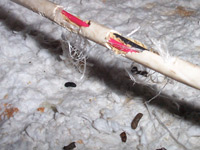 Most people object to squirrels largely
because they don't like to hear all of the
noise and
running around up in the attic. However,
squirrels often cause serious problems.
Squirrels, like all rodents, chew and gnaw
in order to wear down their teeth. They
often chew on your house, either the
inside or outside. They like to chew on
all sorts of surfaces, such as the lead
piping around plumbing stacks, vents,
wires, and of course wood. Although I've
seen several cases in which they've chewed
through and burst PVC plumbing piping,
resulting in flooding or water damage,
it's really the wires that is the big
problem. A chewed upon and exposed
electrical wire is a fire hazard - a
fairly high percentage of house fires of
unknown origin are believed to be a result
of rodent wire exposure.
Most people object to squirrels largely
because they don't like to hear all of the
noise and
running around up in the attic. However,
squirrels often cause serious problems.
Squirrels, like all rodents, chew and gnaw
in order to wear down their teeth. They
often chew on your house, either the
inside or outside. They like to chew on
all sorts of surfaces, such as the lead
piping around plumbing stacks, vents,
wires, and of course wood. Although I've
seen several cases in which they've chewed
through and burst PVC plumbing piping,
resulting in flooding or water damage,
it's really the wires that is the big
problem. A chewed upon and exposed
electrical wire is a fire hazard - a
fairly high percentage of house fires of
unknown origin are believed to be a result
of rodent wire exposure.
 Okay, how do you get them out?
First of all, it's important to
acknowledge that there's no simple
easy-does-it product that will get them to
leave. Some of the ridiculous products and
attempts that I've seen over the years
include the use of mothballs, ammonia, fox
or coyote urine, high-pitch sound
machines, strobe lights, and more. I once
entered an attic with 60 pounds of
mothballs! The house stunk and the
inhabitants got sick - but the squirrels
stayed! One attic had seven of those
ultrasonic sound emmitters - the squirrels
didn't care at all. There's a lot of
gimmicks and old wive's tales out there,
but the only real way to get squirrels out
of the attic is to physically remove them
- such as in live traps.
Okay, how do you get them out?
First of all, it's important to
acknowledge that there's no simple
easy-does-it product that will get them to
leave. Some of the ridiculous products and
attempts that I've seen over the years
include the use of mothballs, ammonia, fox
or coyote urine, high-pitch sound
machines, strobe lights, and more. I once
entered an attic with 60 pounds of
mothballs! The house stunk and the
inhabitants got sick - but the squirrels
stayed! One attic had seven of those
ultrasonic sound emmitters - the squirrels
didn't care at all. There's a lot of
gimmicks and old wive's tales out there,
but the only real way to get squirrels out
of the attic is to physically remove them
- such as in live traps.
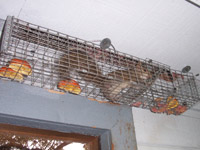 Trap and Remove the Squirrels The
best way to ensure that you'll permanently
take care of your squirrel problem is to
trap and remove the squirrels. You can set
squirrel-sized cage traps on the roof near
the entry holes, but there's a chance that
you'll catch a non-target squirrel. The
best bet is to mount a trap right against
the hole that the squirrels are going in
and out of. Squirrels are active primarily
during the morning and evening, but they
go in and out of the house several times
each day, as they exit to forage for food
and water, and they sometimes return with
food to store. If you mount a trap right
on their hole, you'll catch them as they
come out. Use a repeating type trap like
the one shown, and you can catch them all
at one time! See: squirrel
trapping tips.
Trap and Remove the Squirrels The
best way to ensure that you'll permanently
take care of your squirrel problem is to
trap and remove the squirrels. You can set
squirrel-sized cage traps on the roof near
the entry holes, but there's a chance that
you'll catch a non-target squirrel. The
best bet is to mount a trap right against
the hole that the squirrels are going in
and out of. Squirrels are active primarily
during the morning and evening, but they
go in and out of the house several times
each day, as they exit to forage for food
and water, and they sometimes return with
food to store. If you mount a trap right
on their hole, you'll catch them as they
come out. Use a repeating type trap like
the one shown, and you can catch them all
at one time! See: squirrel
trapping tips.
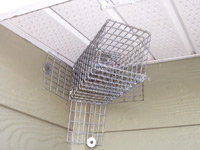 One-way Doors Another effective
and humane way to get the squirrels out is
to mount a special one-way door on the
squirrel's hole. The one-way exclusion
door has a tension flap that allows the
squirrel to exit, but not re-enter. It's
just like the repeating trap, but with an
open end. A one-way door is great at
getting them out so long as they have no
other ways of getting back in. Sometimes a
house will have many holes and open areas
that the squirrels can use. A one way door
isn't very effective if a squirrel can
just use another area to get back in!
Furthermore, it may not be a good idea to
do this in a house with a lot of wood
trim, because a squirrel might go nuts
chewing the house to try to get back in.
One-way Doors Another effective
and humane way to get the squirrels out is
to mount a special one-way door on the
squirrel's hole. The one-way exclusion
door has a tension flap that allows the
squirrel to exit, but not re-enter. It's
just like the repeating trap, but with an
open end. A one-way door is great at
getting them out so long as they have no
other ways of getting back in. Sometimes a
house will have many holes and open areas
that the squirrels can use. A one way door
isn't very effective if a squirrel can
just use another area to get back in!
Furthermore, it may not be a good idea to
do this in a house with a lot of wood
trim, because a squirrel might go nuts
chewing the house to try to get back in.
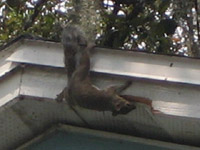 Exclusion Repairs Squirrels are
persistent. They also leave behind a
strong squirrel pheromone scent. If you've
had squirrels in your attic, even if you
get rid of them, new squirrels will smell
that squirrel smell and try to live in
your house in the future. In order to
permanently solve any squirrel problem,
you've got to make sure that your house is
100% squirrel-proofed. This means making
sure that all roof vents have a heavy
steel screen intact, all of the plumbing
stacks are screened off (sometimes the
pipes are open inside the attic), all of
the ridge cap plugs are intact, the gable
vents are screened, the soffits are
intact, etc etc. All repairs should be
performed with steel and bolts, so that
the squirrels can't chew through the
repairs.
Exclusion Repairs Squirrels are
persistent. They also leave behind a
strong squirrel pheromone scent. If you've
had squirrels in your attic, even if you
get rid of them, new squirrels will smell
that squirrel smell and try to live in
your house in the future. In order to
permanently solve any squirrel problem,
you've got to make sure that your house is
100% squirrel-proofed. This means making
sure that all roof vents have a heavy
steel screen intact, all of the plumbing
stacks are screened off (sometimes the
pipes are open inside the attic), all of
the ridge cap plugs are intact, the gable
vents are screened, the soffits are
intact, etc etc. All repairs should be
performed with steel and bolts, so that
the squirrels can't chew through the
repairs.
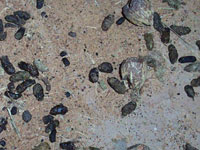 Cleanup As mentioned, when
squirrels live in an attic, they poop and
pee a lot. They can leave large amounts of
droppings and urine in an attic. It's not
just unsightly or bad-smelling - it could
potentially pose a health risk. Most
droppings grow mold over time, and most
droppings contain salmonella. Squirrels
may urinate or defecate on the items you
store in the attic, or they might even
chew right through the drywall. The urine
and the fur grease that the squirrels
leave behind is a potent lure to other
animals, both predators and other
squirrels. Sometimes a raccoon will break
into an attic that has a squirrel scent.
Or other squirrels will enter, looking for
a proven place to live, or a mate. It's a
good idea to clean up, remove, decontaminate
and deodorize the attic.
Cleanup As mentioned, when
squirrels live in an attic, they poop and
pee a lot. They can leave large amounts of
droppings and urine in an attic. It's not
just unsightly or bad-smelling - it could
potentially pose a health risk. Most
droppings grow mold over time, and most
droppings contain salmonella. Squirrels
may urinate or defecate on the items you
store in the attic, or they might even
chew right through the drywall. The urine
and the fur grease that the squirrels
leave behind is a potent lure to other
animals, both predators and other
squirrels. Sometimes a raccoon will break
into an attic that has a squirrel scent.
Or other squirrels will enter, looking for
a proven place to live, or a mate. It's a
good idea to clean up, remove, decontaminate
and deodorize the attic.
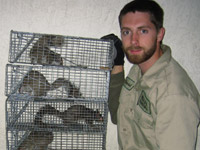 Hire a Pro? Another option is to
hire a professional wildlife removal
specialist. Many people simply think that
wildlife issues are "do-it-yourself" type
things. They are not. In my opinion,
wildlife control issues are more complex
with more at risk than other types of
work, such as plumbing or electrical work.
Plus, there are usually laws regarding the
trapping and removal of wildlife that
typically prohibit homeowners from
attempting the work themselves. Many jobs
are very complex and require professional
attention - are you really going to find
the nest in the attic, remove the baby
squirrels, humanely and effectively trap
the target adults, avoid non-target
catches, identify and seal all the holes,
find and repair chewed wires, clean the
biohazard, and solve the squirrel problem
correctly?
Hire a Pro? Another option is to
hire a professional wildlife removal
specialist. Many people simply think that
wildlife issues are "do-it-yourself" type
things. They are not. In my opinion,
wildlife control issues are more complex
with more at risk than other types of
work, such as plumbing or electrical work.
Plus, there are usually laws regarding the
trapping and removal of wildlife that
typically prohibit homeowners from
attempting the work themselves. Many jobs
are very complex and require professional
attention - are you really going to find
the nest in the attic, remove the baby
squirrels, humanely and effectively trap
the target adults, avoid non-target
catches, identify and seal all the holes,
find and repair chewed wires, clean the
biohazard, and solve the squirrel problem
correctly?
For advice on other critters, please see my animals
in the attic guide, covering everything from
rats to bats to raccoons. Also, keep in mind that
they sometimes live in the chimney as well. Read How
to Remove a Wild Animal in the Chimney.
Read more articles I wrote about squirrels:
What do squirrels do with their tails?
What kind of noises and sounds do squirrels make when they live in your house?
How big do squirrels get?
How to scare a squirrel away
How To Get Rid Of Squirrels Without Killing Them
Do squirrels remember where they bury nuts?
Do squirrels kill mice, rats, or birds?
What to do about a squirrel in the fireplace
How smart are squirrels?
How Long Does It Take To Remove Squirrels In A Building?
Home Remedies To Keep Away Squirrels And Get Rid Of Them
Should I Feed Squirrels For Fun?
What does squirrel feces look like? Where is it found?
The Fastest Way To Get Rid Of Squirrels
How to stop squirrels from chewing on your house or plants
Will a squirrel chew through the ceiling?
Do squirrels attack or bite people?
What attracts squirrels?
Are squirrels ever active at night?
Don't forget - the squirrel in your attic is most
likely a female with young. If you hear only one
animal, the female is soon to give birth, or more
likely has a nest of immobile young. Don't remove
her at this time, or you'll strand the nest of
baby squirrels in your attic. Wait until the young
are up and about - it doesn't take long, because
they grow very fast, and reach adult size in just
six weeks. Once you hear the pitter-patter of
several squirrels, like five of them, then you
know the young are mobile, and they are capable of
being excluded or trapped at that time.


















